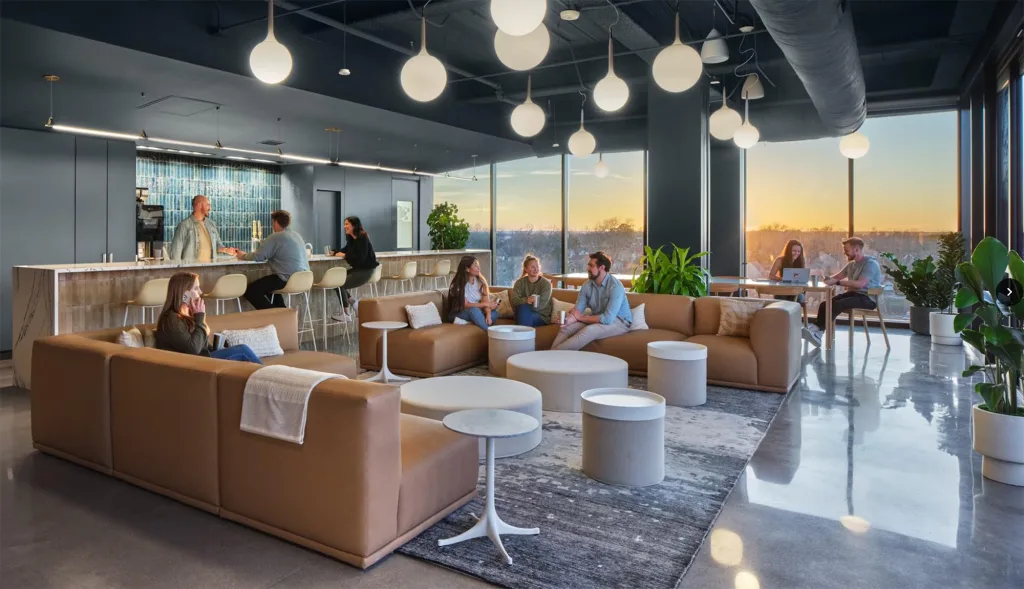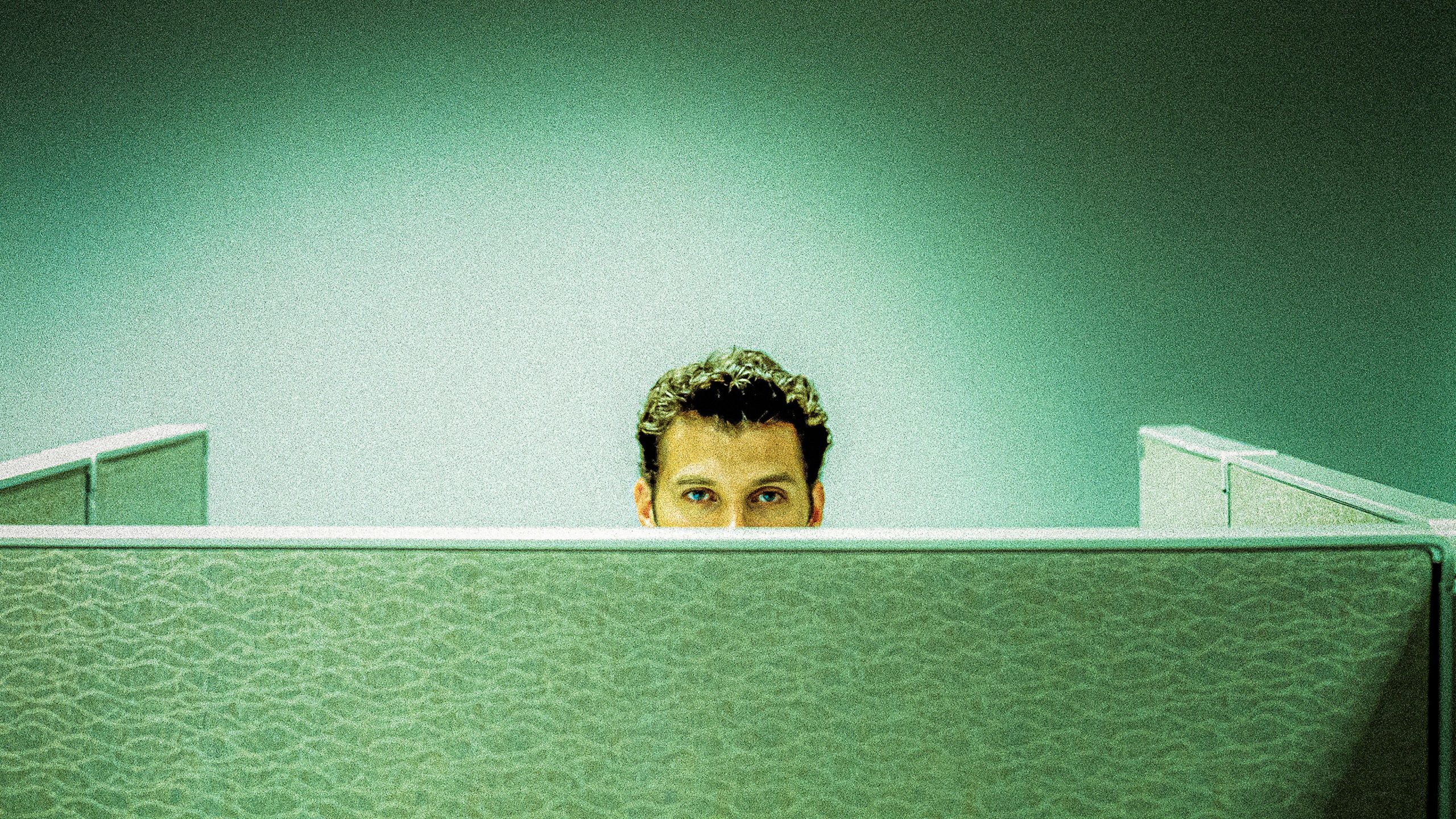This simple idea can transform an office from a collection of cubicles into an actual community
Office design has a lot to learn from urban design.
Across industries, from boardrooms to break rooms, the return-to-office conversation has focused on the ideal split between home and office. Corporate leaders and employees alike often cite culture and connection as reasons to gather together. But making the commute only to arrive at a sea of half-empty desks and traditional conference rooms can suck the life out of even the most devoted office attendee.
Explanations for return-to-office fallout vary from industry to industry, and company to company. But what becomes clear is that employees have been left with little to no incentive to be in the office, and in some cases will even leave their current employers to avoid it—a trend we’re seeing now at tech giants like Apple and SpaceX, but is by no means limited to one industry.
As a result, the attention is turning to what may prove to be a far more important question in determining how we work in the future: Are offices actually designed to effectively support the ways people now work? At the present moment, the answer is no. But they can be, by borrowing design principles from the spaces in our neighborhoods and communities where people gather together.
The Office Disrupted
Even before the pandemic, workplaces around the world were changing. As Wi-Fi and mobile technologies became widely available in the early 2000s, people started to spend more time in spaces beyond the office. Even within offices, sensor data from a short-term repeat study conducted with customers from Herman Miller stores indicates that the average time workers spent at their desks dropped from 47% in 2010 to 33% by 2018.
Once the pandemic hit, the way many people worked changed overnight. Between 2019 and 2021, the number of US workers primarily working from home tripled (US Census Bureau) growing to roughly 27.6 million people, and today fewer than half of American companies require employees to work full-time in the office.
Hybrid policies make it difficult to predict who might be in the office on a given day, increasing the pressure on employers to create meaningful gatherings and meet the heightened expectations employees have for their time spent in-person. Lower office utilization is also fueling ongoing concerns about the future of cities, as central business districts suffer from increased office vacancies and decreased traffic to local businesses.
In order to ensure a better future for the physical workplace and the cities in which they’re located, offices need to facilitate connection, support varied and flexible work arrangements, encourage in-person collaboration, and ultimately deliver greater value to employees and organizations.

Evolved Priorities
Employees coming in the office are often doing so to fulfill one or more distinct needs. On one hand, people are seeking interpersonal experiences not easily had remotely, such as content-rich group gatherings, unstructured time with colleagues, opportunities for cross-team socialization, or longer-form collaboration not supported by video conferencing. On the other hand, people are also looking for spaces that allow them to escape distractions at home, and do concentrated, focused work in quiet areas where they can think creatively without interruption.
Right now, it’s clear that offices featuring rows of open desks and generic conference rooms fall short, straddling the middle and not supporting either experience particularly well. Furthermore, traditional office designs emphasize hierarchy and status and are planned to help managers physically supervise work. Such a layout can communicate to employees that these spaces are built for leaders, not for them. Instead, spaces that focus on promoting wellbeing, improving connection, and facilitating change offer improved value for employees who are now empowered to work where they think is best.
The Office Reimagined
So, what’s the solution? It begins by shifting away from desks and conference rooms and allocating space for different work settings to support experiences not easily had at home.

Interestingly, the best guides for rejuvenating the office can be found elsewhere in urban planning. We can gain inspiration in supporting large group gatherings from educational campuses, community centers, and event venues. Understanding neighborhood designs, and how local cafes, pubs and other “third places” build community can help create connections between employees. Libraries, art studios, places of worship and parks can teach us how to spark creativity and contemplation. While these places are not primarily designed for desk-based work, understanding what makes them special informs how we can redesign offices with the same desirable qualities.
They may have communal spaces where individuals or groups can work or converse, or seating and tables that can be easily rearranged for socialization and collaboration. Perhaps they incorporate green spaces for patrons to use. Whatever the case, the spaces in which we gather can be a valuable resource for shaping offices to better fit the ways we interact with one another. Often, the redesign of offices towards a landscape of settings can be done in less space, allowing organizations to reinvest real estate savings into smaller but more desirable and lively spaces.
Designing with Impact
This approach to office redesign is not just theory —it’s been tested for decades. During the mid-century design era, a new approach called “Office Landscaping” emerged, where office design began to reflect urban planning principles. Companies have done this before, and many continue to do so today.
Take the Ledger, a new building in Arkansas offering flexible lease terms to organizations who are experiencing a high degree of change or growth. The space is highly diversified with a variety of space types to support everything from social collaboration to video-enabled project rooms, and invites the surrounding community into public spaces offering coffee shops and even retail stores.
In Des Moines, Iowa, the workspace at the Harkin Institute of Public Policy is designed with input from administrators, faculty, and students and blurs the realm of public and private spaces. There are desks for each employee, but the space is primarily designed to help people socialize, connect, co-create, and learn, and an emphasis on inclusive design reflects the Institute’s focus on disability advocacy while helping everyone to belong.
The pandemic shifted our understanding of how we work. Now, we need to shift our concept of what an office is. Simply put, we still need offices, but not the offices of the past. Instead of seeing offices as a container for rows of desks for individual work, we can reimagine them as assets to facilitate connection, wellbeing, and change. By recognizing that organizations are communities and that spaces are fundamental to how communities thrive, we can breathe new life into offices and the cities in which they reside.
ABOUT THE AUTHOR
(13)
Report Post




